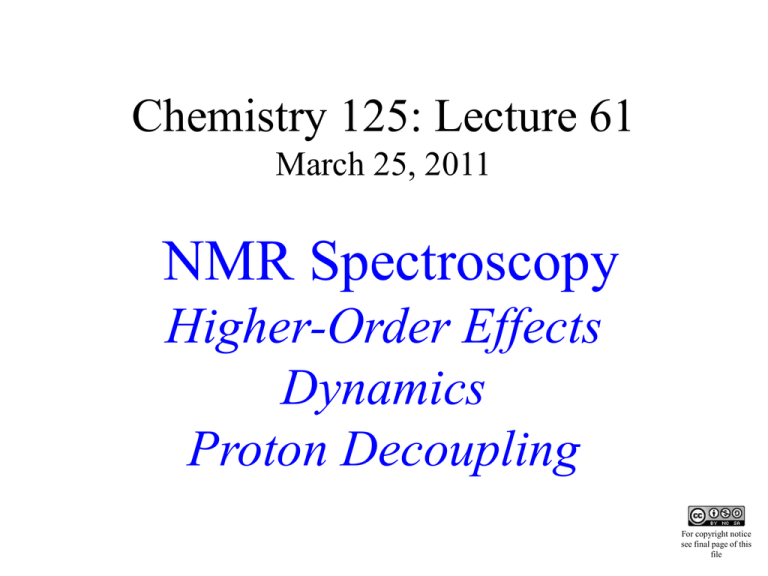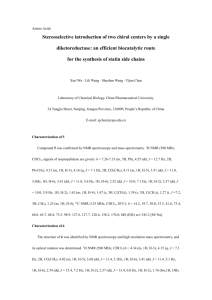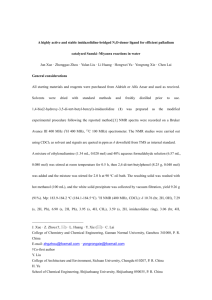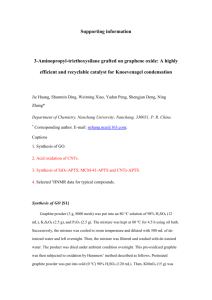
Chemistry 125: Lecture 61
March 25, 2011
NMR Spectroscopy
This
Higher-Order Effects
Dynamics
Proton Decoupling
For copyright notice
see final page of this
file
Spin-Spin Splitting:
Other Nuclei &
Higher-Order Effects
J
13
C-H
99% of sample is C12
Coupling electron must be on the C13 nucleus.
Amplify 30x
(instrumental
artifact)
126 Hz
Hybridization and J coupling
(Hz)
C
C
C
(-CH2-)
C
C
(-CH2-)
C
C
( C-H)
( CH2)
C
C
sp3
Three
Populations
2
sp
sp
Why does CH4
give a single
unsplit peak
instead of a
quartet?
7.700
7.647
1.270
0.053
Chem 220
15.7 Hz
NMR Problem 7
7.673
Unsymmetrical
Doublets
381 Hz
mess!
Bo (T)
d (Hz) / J (Hz)
7.05
(3002.89
MHz)
0.86
0.29
0.06
24.4
10.0
3.0
0.5
0.2
6.429
6.377
0.052
15.6 Hz
6.403
Cinnamic Acid
8
7.5 100
200
Change to Frequency Scale
07
dHz
(ppm)
-100
6.5 -200
6
Energy of Nuclear Spin States in Bo
O
“Higher-Order” Effects
J/4
1/√2(
p*
O C
O C
p
C
d
J/4
J also mixes
with
toward
) & 1/√2(
This influences
Suppose the spins
the intensity of
interact favorably
the transitions.
as magnetic
when antiparallel.
5 to see the
J/4 Enlarge by ~10perpendicular
d/2 ppm energy difference
to and
Bo blue
as
or
between red
environments
J
)
non-magnetic
.
C=O
analogy
J/4
d
chemical shift
J
Rf light loses its
“handle” on the
flanking peaks as
d becomes small
compared to J
J
3
d
1
0.6
By increasing d (Hz)
a strong magnet reduces asymmetry
and gives “ideal” pattern.
Note: d is measured in
Hz (not ppm) between the
weighted average
positions of the lines in
the two doublets
0.2
Dynamics
(the NMR Time Scale / Decoupling)
e.g. J&F Sec. 15.9 pp. 746-749
Sec. 15.6e p. 739
DMSO
H+
HOCH2CH3
CDCl3
2.00
average of many
HOCH2CH
3
HOCH2CH3
1.00
2.00
1.14
2.00
+
CDCl3 H
H+
DMSO
CDCl3
CDCl3 H+
H-bond structures
3.05 on
(dependent
concentration,
solvent,
& temperature)
3.03 OH
CH3CH
2
spin-spin
splitting?
average for H
exchange among
many molecules,
(fast with H+
slow in DMSO)
spectra courtesy of P. Lichtor
0.96
ROH
chemical
3.04
shift?
R
O HH
H
O R
H
O HH
R
d-
d+
CD3
O H O S
R
CD3
Form A
Form A
Why doesn’t
(This particular sample
IR show OH is a solid, but no averaging
is observed in solution
averaging? spectra either.)
110 x 1010 Hz
102 x 1010 Hz
Difference ~ 1011 Hz
How long does it take to measure frequency precisely?
light field
20 Hz
But a 1 sec pulse samples full range of phases.
21 Hz
No netwith
interaction
Match
a short with
pulselight.
of
20pulse
Hz light
is nearly as
1 sec light
distinguishes
20good.
Hz from 21 Hz.
22 Hz
0.5 sec (1/) is long enough to sample the
full range, favorable and unfavorable.
1 second
What if a proton changes frequency faster than 1/?
20 Hz
21 Hz
Very good match with the 21Hz average frequency single, sharp peak.
22 Hz
20 Hz
22 Hz
1 second
20 Hz
22 Hz
22
20Hz
Hz
When do Peaks Average?
When atoms don’t stay put
long enough to tell the
difference in frequency.
e.g. If two peaks differ by 100 Hz, you must
count for ~0.01 sec to tell them apart.
These IR peaks differ by 1011 Hz.
Exchange of position is not that fast.
The NMR Time Scale
Single, sharp peak
at room temperature,
even for C6H12
Handy way to
measure fast rates
and small barriers
Cyclohexane-d11
d11 to avoid complications
from spin-spin splitting
-49
D
-57
Coalesce with
lifetime ~ 4
-60
Barrier
10.5 kcal/mole
-63
D
-68
-89
(°C)
= 29 Hz
(0.48 ppm at 60 MHz)
F. A. Bovey (1965)
a
b
c
Almost anyplace (d 1-6) depending
on concentration and temperature
(averaged H-bonding)
Probably no splitting (broad singlet)
because of rapid OH proton exchange
among different molecules
Slightly deshielded by two oxygen
atoms on neighboring carbon
d 1-2 (a real analogue is at d 1.3)
1:1 doublet from single H on
neighboring carbon (J about 7 Hz)
Deshielded by two oxygen
atoms on the same carbon
d 4-5 (a real analogue is at d 4.7)
1:3:3:1 quartet from three H atoms on
neighboring carbon (J about 7 Hz)
d
e
f
Slightly deshielded by oxygen
atom on neighboring carbon
d 1 (a real analogue is at d 1.1)
Deshielded by oxygen atom on
the same carbon (but less than c)
d 4 (a real analogue is at d 3.8)
Slightly deshielded by oxygen
atom on neighboring carbon.
d 1 (a real analogue is at d 1.1)
different from d (diastereotopic)
1:1 doublet from single H on
neighboring C (J about 7 Hz)
Seven line multiplet from 6 H atoms on
neighboring carbons (J about 7 Hz)
1:1 doublet from single H on
neighboring carbon (J about 7 Hz)
Proton Decoupling
25 MHz
100 MHz
(in frame rotating
at 100 MHz)
13C
C13 NMR
spectrum
irradiate H (100 MHz)
and pulse (25MHz)
to observe C13
H
H NMR
spectrum
or
or
J ~ 125 Hz
H up
H average
H down
Decoupling Power
determines the rate
of this precession.
C13 up
C12
C13 down
End of Lecture 61
March 25, 2011
Copyright © J. M. McBride 2010. Some rights reserved. Except for cited third-party materials, and those used by visiting speakers, all
content is licensed under a Creative Commons License (Attribution-NonCommercial-ShareAlike 3.0).
Use of this content constitutes your acceptance of the noted license and the terms and conditions of use.
Materials from Wikimedia Commons are denoted by the symbol
.
Third party materials may be subject to additional intellectual property notices, information, or restrictions.
The following attribution may be used when reusing material that is not identified as third-party content:
J. M. McBride, Chem 125. License: Creative Commons BY-NC-SA 3.0






